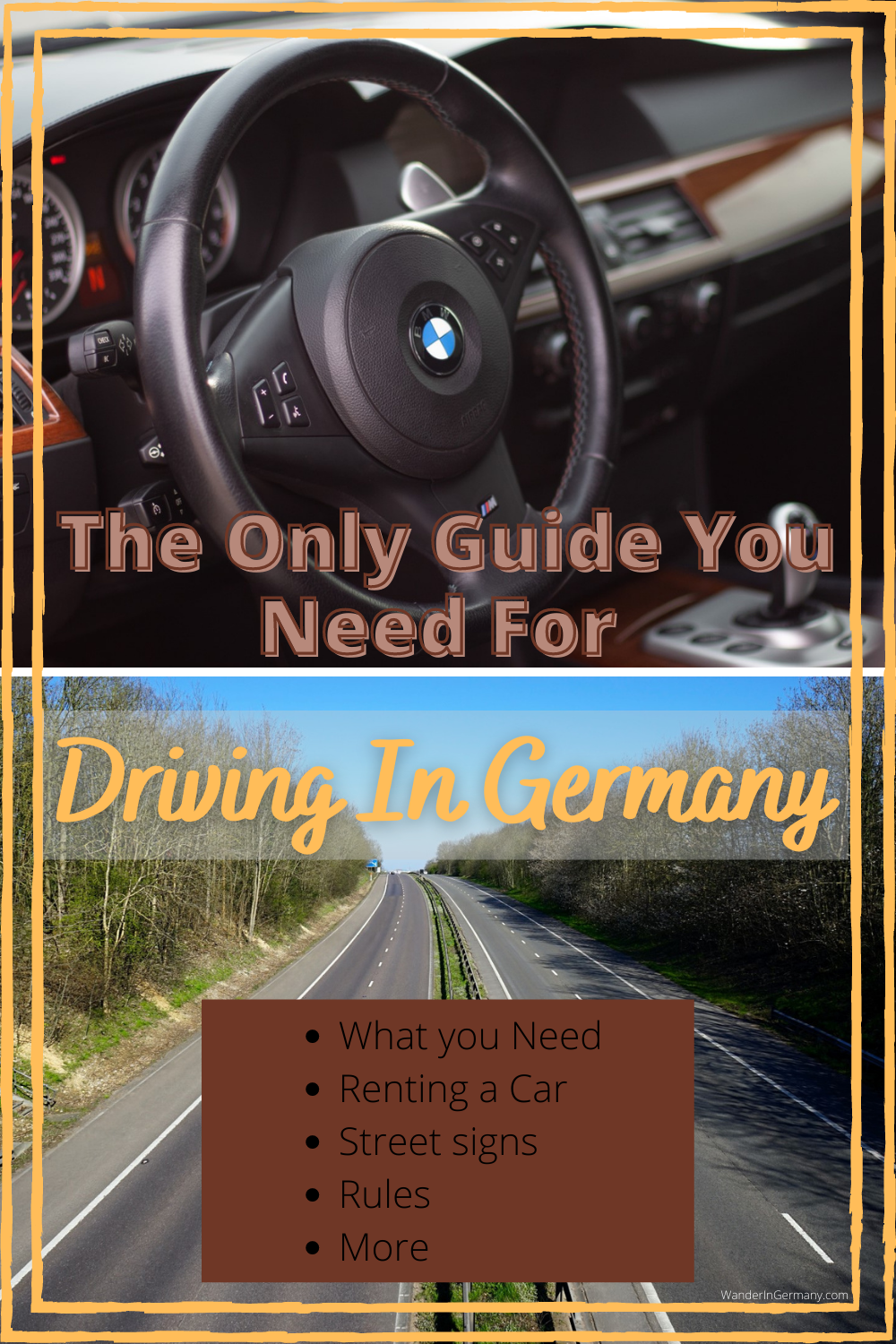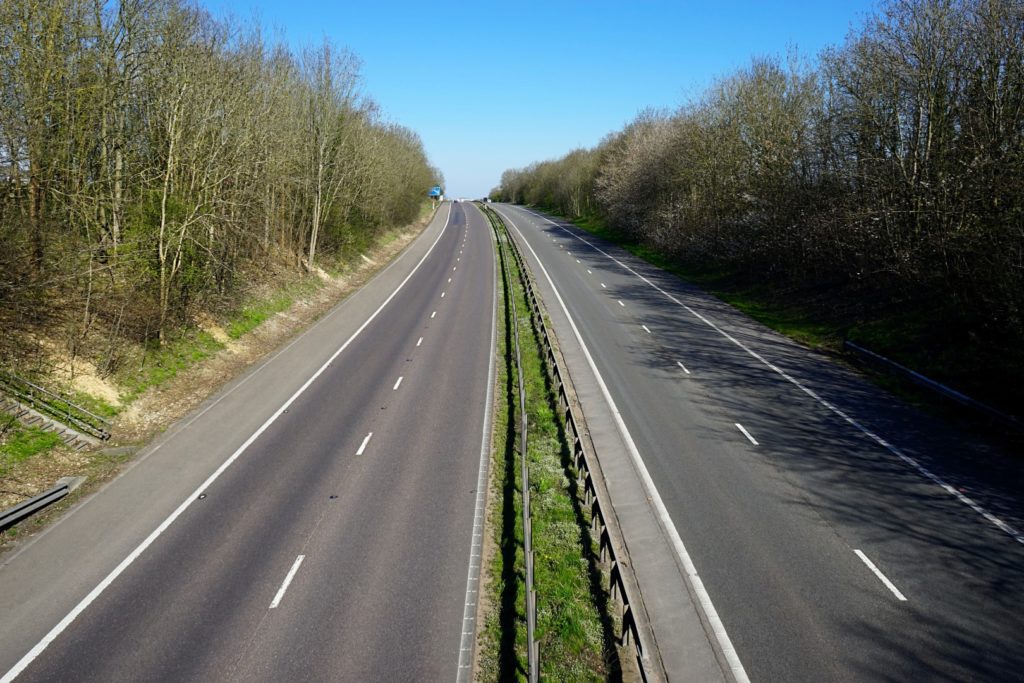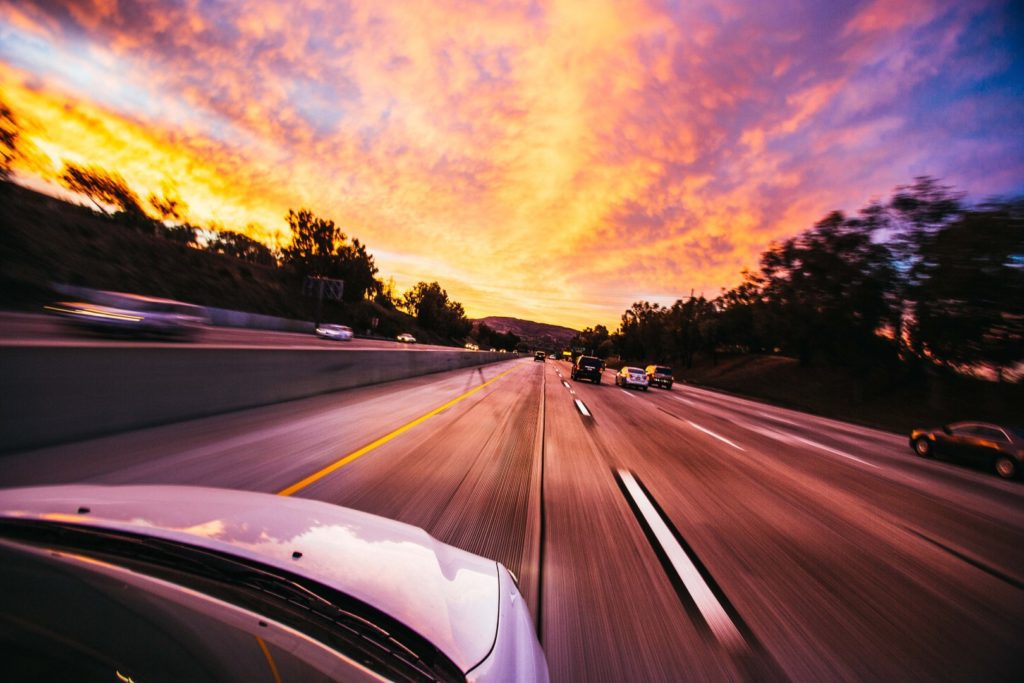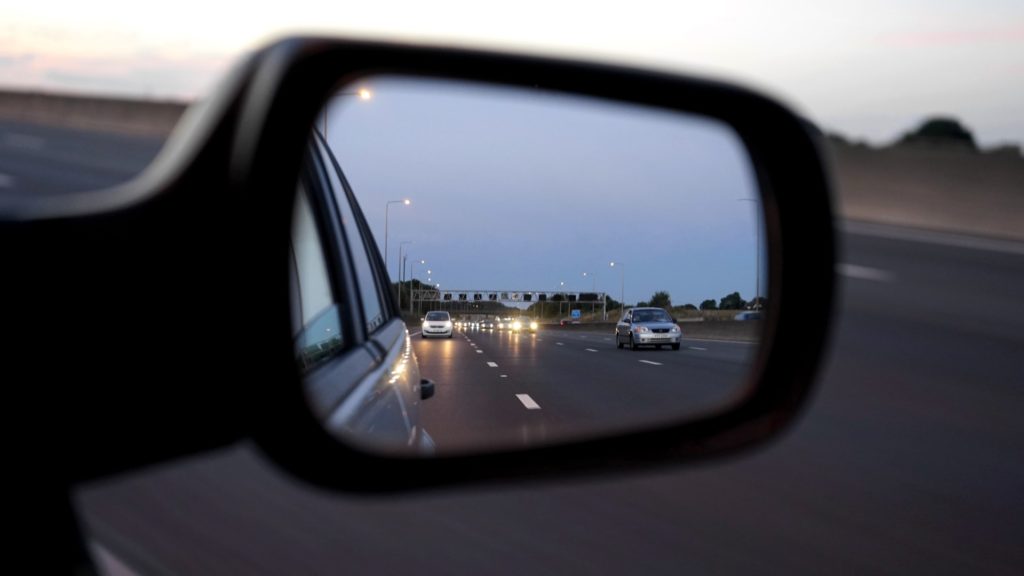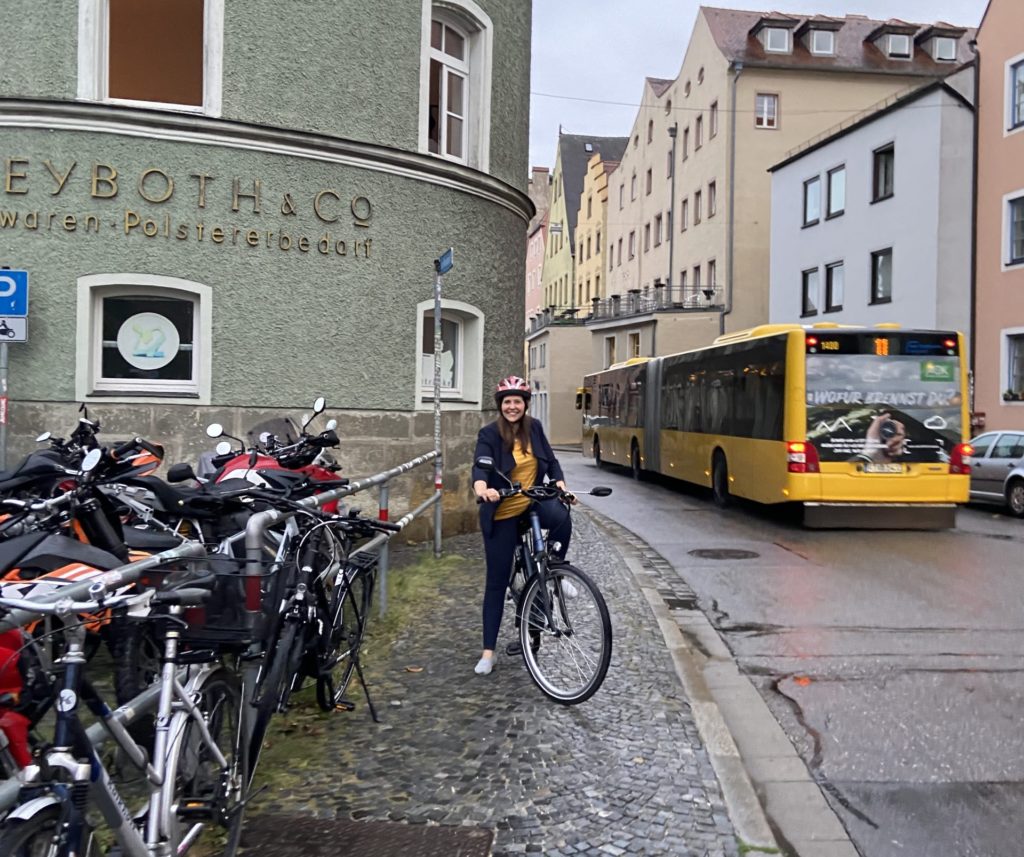When planning a trip to Germany, one question you might be having is how to get around the best. Depending on where all you want to go, your three main options are driving through Germany, taking the German Trains, or doing short flights. All three options have their time and place, but I personally love the flexibility of driving, especially when wanting to get to some more of the off the beaten path locations.
The roads in Germany are impeccably maintained, well marked, and some have absolutely stunning scenery along the routes!
But I totally understand the hesitancy towards Germany driving. That’s why this guide is going to give you all the driving in Germany tips I’ve acquired after living here for years. By the end of this guide you’ll understand what the driving requirements in Germany are, you’ll feel more at ease understanding the Autobahn etiquette and laws, you’ll know the most essential driving in Germany rules, and we’ll answer the famous question of “Does Germany have speed limits?” so that you can have a stressfree, enjoyable road trip through Germany!
Planning Your Trip To Germany? Read Our “Know Before You Go” Guide
^Pin It For Later to Your “Germany Trip Planning” Board^
You'll Find In This Article:
Planning a Trip to Germany? Join Our Fantastic Traveling in Bavaria Facebook Group!
Driving a Car in Germany FAQs
First, let’s get some very basic, Frequently Asked Questions about driving in Germany out of the way. Most of these questions will be covered in in-depth further on in the detailed sections.
When Driving in Germany, Which Side of the Road Do They Drive On?
Right. In Germany, they drive on the right side of the road. And no, I don’t mean the “correct” side. Simply put, when driving, you’ll be driving on the right hand side.
Is Driving Around Germany Easy?
Yes. Driving in Germany only has a few slight differences from driving just about anywhere else in the world. While there are a few small things to know about (such as yielding to the right to vehicles at some intersections), for the most part, driving in Germany, (yes, even driving on the Autobahn!) is very straight forward and simple.
Is There a Speed Limit on the Autobahn?
One of the reasons why people ask “Is driving in Germany hard” is because they have heard that there is no speed limit in Germany. This is both true and false.
There are sections of the Autobahn that, in fact, do not have a speed limit. The general “rule” though is that you can not drive recklessly and you must always maintain control of your vehicle. However, if you have exceeded 130km/hr (about 80 mph) and get into an accident, then you will be held liable.
However, there are plenty of sections of Autobahn that do have speed limits, and everywhere off the Autobahn absolutely have limits.
How Fast Can You Drive in Germany?
- When driving in towns, the speed limit is automatically 50 kmh unless stated otherwise
- When driving out of towns, the speed limit is automatically 100 kmh unless otherwise stated
- NOTE: There will not always be a speed limit sign! Therefore, you need to know that as soon as you enter a village or “built up” area that that automatically means the speed limit is 50!
And what about the Autobahn? If there is no speed limit, just how fast CAN you drive on the German Autohbahn? Well, in recent years, a Czech millionaire posted a video where he went a whopping 417kmh (260 mph)!!! However, he is now under investigation for reckless driving and is facing jail time. So, while there may not be an official limit, that doesn’t mean you can be stupid.
What Do I Need to Drive in Germany?
- A current, valid driving license in your country of residence
- Proof of insurance
- Registration and proper documents in the car
- Minimum of 18 years old (note: The Germany car rental age is 21 and many companies will even say 25)
I’ll go into further details about this below.
Do I Need an International Driving Permit for Germany?
Technically, no. If you are driving in Germany as a tourist (IE: you are staying for less than 3 months) then it is not a German driving law to require an IDP (International Driving Permit). HOWEVER, many German car rental companies may require this for their own purposes so it is important for you to inquire about this if you plan on renting a car in Germany.
Are There Driving Tolls in Germany?
No. Unlike many countries in Europe, Germany has no toll roads. Germany also does not require a vignette for driving. However, if you plan on crossing borders, many surrounding countries (such as France, Italy, Austria, and Czech Republic, Poland) require Vignettes for motorways and/or have frequent Tolls (and sometimes both!)
Do You Need a Car in Germany?
No, absolutely not. Germany’s train system is phenomenal and can get you to just about every nook and cranny. However, having a car in Germany allows you to have a lot more flexibility with your schedule or can get you to places that trains might just take too long to get to.
Read My Germany Trains Explained Here and How To Buy Deutsche Bahn Train Tickets Here
Where is the Autobahn Located in Germany?
All over. The Autobahn is the German equivalent of the Interstate system or Motorway. They are denoted by the “A” before a number. Generally speaking, if it is an even numbered route, like the A2, then that signifies that it runs East to West. If it is an odd number, such as the A9, then it means it runs North to South.
Autobahns are not the same as “highways.”
Is It Safe to Drive in Germany in December?
Germany does an impeccable job of clearing roads during snow and preparing for ice. However, if the weather is suspected to be bad, driving in Germany in the winter is just like driving anywhere else that has snow or ice, and caution, slow speeds, and experience driving in those conditions is preferred.
Are Winter Tires Mandatory in Germany? Are Snow Chains Required for Driving in the German Alps?
Winter or All Season tires are one of the requirements for driving in Germany in the winter. If you are renting a car, you can verify that your vehicle does in fact have these if you will be driving in the winter in Germany. You’ll know the tires are winter or all season if there is a “snowflake” symbol on them.
Chains are not required in most locations, especially ones that tourists will frequent. For example, if you plan on going to Neuschwanstein Castle in the Winter, you do not need snow chains for this trip. We’ve been to places like Garmische to visit the Zugspitze in the winter as well as have gone skiing in locations all over Southern Germany and have never needed chains since most of those locations have Gondolas up to the top.
However, depending on just how high up or off the beaten path you are planning on getting, then some mountain roads do require it. It will be denoted with a blue sign with a chain covered in tires with the words. ” Schneekettenpflicht!” (Snow chains mandatory)
What is the Best Car Rental in Germany?
Lately, I have been finding RentalCars.com to have some of the most affordable car rental options. In fact, in a recent search on Expedia vs RentalCars, RentalCars was about $45 cheaper per day. I also often have really good luck with Sixt a lot for great prices as well.
- Many will require a € 1000 refundable deposit (held on your credit card and refunded upon return)
- Check if there is a maximum Kilometer threshold. Some on CarRentals.com have a max of 300 km, whereas I’ve seen most on Expedia say you have up to 187 km per day. If you plan on driving a lot, you will want to do these comparisons.
Compare Car Rentals on Expedia vs RentalCars.com
Traveling in Bavaria? Don’t forget to read my “Ultimate Guide to the Bayern Train Pass”
Driving in Germany Requirements
There are actually just a few driving requirements in Germany for tourists. However, do note that things like where else you might be traveling to, or even your country of residence may impact a few of the factors. Here is the bare minimum of what you’ll need in order to drive in Germany:
- Must be 18 years of age (see my notes on ages in the “Renting a Car Section” if you are under 25)
- Valid and current Driver’s Licence from your home country
- Valid and current Passport
- Valid Car Insurance. (Note: Your US insurance may not cover you driving in Europe. Call your auto insurance first to verify this. However, many credit cards today actually have auto insurance that is included in their benefits at no additional cost. Call your credit card next to see if they cover you. If not, you may be required to purchase additional insurance through your car rental agency.)
Do I Need an International Drivers Licence for Germany
Notice how this wasn’t on the “required” list? So here’s the deal…
If you are staying less than 6 months (most tourist visas are only 3 months anyways) then you actually don’t require an international license in Germany if you have all of the above documentation.
HOWEVER, if you plan on renting a car, the individual agency may require one (so always check this ahead of time) or if you plan on driving outside of Germany, for example for a quick dip into Austria, then they do require one.
Also, while technically your valid license may suffice, if you were to get pulled over, having an international permit is extremely handy. An international license/ permit for tourists is simply a translation of your own license, so this can help speed things along or reduce any confusion with the Politzei.
Getting an International Driving Permit For Germany
Since it’s easy and pretty cheap to get an international permit, most tourists like to get one for peace of mind. For US residents, you
have to be a minimum of 18 years old and your current license must be at least 6 months or older.
- Find a local AAA or AATA office
- Pay a small fee (typically about $20) to the agency
- Wait 10-15 days for processing time plus several days for mailing. Therefore, you should start your application about a month prior to your Germany trip
What You Need To Submit
- Copy of the front/back of your valid license
- 2 passport photos
- Processing Fees
Renting a Car In Germany
When renting a car in Germany, I like to book in advance to give me the widest selection possible. I honestly go through several of the search engines below to see which is the best for pricing. However, I often find that Sixt and RentalCars.com often tend to be the best for affordable budgets.
Click Here To See the Lowest Comparisons of Car Rentals in Germany
There are quite a few Agencies that you can rent cars from in Germany such as:
Here are a few of my top Germany Car Rental Tips/ Things to Know
- When driving in Europe, you can expect the majority of cars to be manual transmission. Therefore, if you need an automatic car, you’ll definitely want to book ahead.
- Booking an automatic car will also most likely mean a slightly more expensive daily rate as well.
- You have the best prices when booking in advance (as well as options available)
- Airport rental locations tend to be slightly more expensive than in town
- Most cars are compact cars. If you’ve never driven around on the small alleyways of Germany, you’ll soon understand why most vehicles are smaller, compact cars. Therefore, if you are a family needing a larger minivan, know that it can actually be quite difficult and expensive (as well as cumbersome to actually drive!) to find a van. And remember, just because it is a van does not automatically mean that it will be an automatic transmission! If you find yourself needing a van, definitely book this ahead of time to ensure you have options.
- If your car doesn’t have a GPS built in, just pay the extra fee for one, as it will make life (and driving) so much easier
- Speaking of the “Navi” (GPS), before leaving, ask if your agent can help you switch the Navigation language to English
- As with any car rental, make sure every scratch and ding is reported before leaving just to avoid any misunderstandings upon return
- Ask for a “Parking Disk” (A “Parkschiebe”) as you may need it for certain parking situations (more on that below)
- Before leaving, make sure you know what kind of gas your rental takes. Diesel cars are extremely common here.
Note: When you get a car rental in Germany, the quoted price most likely does NOT include the 19% Value Added Tax (VAT), registration, and airport (if applicable) fees. If you want that total quote, be sure to ask for that.
Size DOES Matter
As I pointed out already that it is hard to get vehicles like a van, even some more commonly found SUVs are still often too big for those small alleyways, VERY tight garage spaces, or narrow alpine passes. The smaller the car, the easier driving will be (and less stress for you, I promise!)
Minimum Age Requirement for Car Rentals
Even though you must be the minimum age of 18 to legally drive in Germany, that does not mean that a rental company will rent to you. Some rental companies have a minimum age of 21 and I’ve even seen some that say 24. If you fall within those ages, it’s best to verify first before booking.
What do you need to rent a car in Germany?
- Valid Driver’s Licence (Check with car rental if International Permit is required with them)
- Proof of 3rd party liability auto insurance
- Passport
- Debit or Credit Card to cover the deposit
- Safety Gear: It is a legal requirement that vehicles have certain safety gear, such as orange vests, caution triangles, and a first aid kit. Verify with your car rental where these are located in your car.
Click Here To See Car Rental Comparison Prices in Germany
Renting a Car in Germany Cost
You can expect to pay anywhere from about $40/ Day for a small, compact car to about $130 for a medium sized vehicle to $150 for an SUV and anywhere in between!
For example, if you need an automatic vehicle, that is going to be more expensive than a manual, stick shift. Likewise, if you need a van for a family, that’s not going to be cheap, either. So, is car rental in Germany expensive? Well, this is really going to depend on the exact car you get/ what your needs are.
Fuel Prices
As I am updating this post in 2022, everyone is feeling the “pain at the pump” but here in Europe, it is not pretty. At the time of this update (March) the cost of gas is the equivalent of over $9 PER GALLON!!!! No, that was NOT a typo. Ouch! Therefore, while I do love Germany by car for the flexibility, for the time being, trains may need to be considered for cost efficiency.
Other Costs:
The following are typically not included in the basic car rental price:
- Kids’ Car Seats
- GPS
- Separate Pick Up/ Drop Off Location
- Certain Insurance Policies
Types of Germany Roads
Knowing the different roads (Strasse) in Germany can help you feel much more at ease navigating around. Plus, this will help when I start to describe some of the German driving rules coming up in the next section.
Autobahn
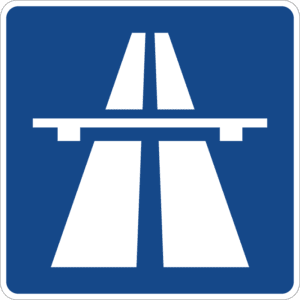
Because this interstate/ motorway system is one of the most famous parts of driving in Germany, I have a full Autobahn guide section below which will cover things like the infamous “Road in Germany without a speed limit” (hint: yes there are sections that do, in fact, have speed limits and I will detail the Autobahn Germany rules you’ll need to know below)
When driving, you’ll often see the Autobahn denoted with an “A” for example, the “A7” which is actually the longest Autobahn in Germany. The Autobahn Signs will all be in Blue. Here is a great list of all the Autobahn Germany Maps throughout the country.
Bundestrasse

The Bundestrasse is like the US’ Highway system. It is very comprehensive and is often a great alternative to avoiding a Stau (traffic jam) on the Autobahn or for those just wanting to avoid the Autobahn. These roads will be denoted with a “B” and be on yellow signs. For example, taking the B17 to Schwangau is a popular route when driving to Neuschwanstein Castle from Munich.
Unless there are speed limits sign on a Bundestrasse, assume these are 100 kmh limits.
Land and Regional Roads
If you are really going off the beaten path between towns, you might find yourself on a ” Landesstraße” or a ” Kreisstraße” which are basically denoted by a letter corresponding to its location. There really is nothing too special to note or know about these roads, except that when you pass through small villages, always, and I mean ALWAYS slow your speed down to 50 kilometers. It is not always signposted, but as soon as you see a yellow village sign, that is the indicator that the speed limit is now 50.
Unless there are speed limits signs, assume these are 100 kmh limits.
Urban/City Roads
Of course, there are streets in the cities. While they aren’t impossible to drive in, I much prefer to find a “P+R” (Park and Ride) lot outside of city limits for bigger cities (Frankfurt, Munich, Berlin, etc), park the car, and then just use public transportation instead of trying to navigate busy streets, the street cars (Trolleys or S-Bahns), and unfamiliar locations.
Unless otherwise noted, assume that these speed limits are 50 kmh limits.
Toll Roads In Germany
Yay! There are actually no toll roads in Germany currently! One less thing to have to figure out and calculate! Huzzah!
Autobahn Etiquette and What You Need To Know
Since driving on the Autobahn has got to be one of the most googled topics of driving in Germany, I would be remiss to not go into detail about this elusive road.
So, what IS the Autobahn!? While I already explained that it is basically Germany’s interstate system, I think the idea of people driving at upwards of 200 kmh gives a lot of people anxiety (me included when I first moved here!) With close to 13,000 kilometers of Autobahns, it is easy to get all over Germany using this roadway system.
So, What is the maximum speed limit in Germany, you might ask? If there are no limit signs, then a driver can actually go as fast as s/he wants as “long as the vehicle is under control.” Yes, that can be upwards of 150 MILES per hour or more.
Still not sure you want to drive the Autobahn? The minimum speed limit on the Autobahn is 60 kmh (that’s only 27 mph!) so you can just chill out in the right hand lane and let all those speed demons pass you by as you truck along. No shame in that game! (Ok, maybe just a little shame, but hey, safety first!)
After getting over my initial nerves to drive on the Autobahn for my very first time, I actually quite enjoy it now. In true German fashion, it is very orderly, everything makes sense, it is all well marked, and there are plenty of rest stops along the way (sorry, I have the world’s smallest bladder). In fact, the first time I came back to the US and drove on the Interstate was the first time in my life I realized I might have road rage, as I grumbled under my breath to the people passing me on my right, or the exits being on the Left side (what is with that!?) I was so ready to get back to Germany and drive on the easy to navigate Autobahns that had clear and concise procedures!
One of my biggest tips for driving in Germany is to just take it slow and steady until you feel more comfortable, which will come quickly, I promise.
While at first glance, tourists driving in Germany on the Autobahn seems exotic, you don’t need any special “Autobahn insurance” or anything extra to drive on the Autobahn (except for a few rules and expectations)
What Are the Autobahn Rules?
While it really is just like an interstate system (but arguably easier to navigate) Here are a few rules and differences to know:
- Always. And I mean ALWAYS drive on the right and pass on the left. This isn’t a suggestion, this is the law. If you get over into the left-hand lane, you better be passing someone on the right.
Tip: If you find yourself cruising in the left hand lane (woops) then you most likely will get Speedy McSpeederson behind you flashing his brights. Keep your cool. Sometimes those BMWs will come flying out of nowhere behind you. If you are passing a car, they may get right up on you, but just get back over into the right hand lane when it is safe to do so. - Watch For an Autobahn Speed Limit. Yes, you read that correctly. Just because a lot of the freeway has no speed limit, there are still sections that absolutely do, especially in locations that tend to have increased traffic, construction zones, or even locations that might bend and curve more than others. The tricky part about this is that one second it might be one speed and the next, it can be significantly lower. And just try to guess where they put speed cameras at 😉
- Move over during a Stau. A Stau is a “traffic jam” and it’s not uncommon to find yourself in one. Move your vehicle as far over to the shoulder as possible to allow for any emergency vehicles to pass easily if needed. If there are three lanes, then the two left hand lanes will move to the left as much as possible.
Also, if you can get into the left lane during a Stau, you might be better off. Those big semi trucks are required to get into the right lane, so you might be able to get moving faster in the left. - Know the major cities along your route. The handy blue signs on the autobahn don’t ever say things like “North or South” but instead will tell you in what direction of a city you might be going in.
- Stop Every 2 Hours of Driving: While this isn’t a LAW, German’s do love their rules, even the unofficial ones, like stopping for rest breaks. Since an accident on the Autobahn can be devastating, Germans take driving on it very seriously. In fact, our first German Audi had a light that started blinking once you had been driving 2 hours as a reminder to pull over, grab a coffee, go to the bathroom, or just stretch your legs.
- Always use your blinkers and indicators. No exceptions
- Double, nay, triple, check before switching lanes. Especially if you are moving from the right to the left lane, those speedy cars can sometimes seem to come up out of nowhere. You may not realize JUST how fast they are going, so always double-check your side-view mirrors and blind spots before switching lanes.
- Stick to Safe Speeds. God forbid you are in a wreck, if you are going over 130 kmh, then you are automatically held liable for an accident. Just because you CAN drive insanely fast doesn’t mean that you should.

Parking in Germany
Parallel Parking:
I got very good at parallel parking after moving to Germany (ok, let’s not lie here, I got BETTER…I still make my husband parallel park if he’s with me!) If you are squeamish about parallel parking, definitely avoid city parking.
Parking Garages
By now you might be getting tired of me mentioning the benefits of having a smaller vehicle while in Germany. If you haven’t heeded my advice yet, then trying to park in a Parking Garage here will surely get you on my side.
The parking stalls seem impossibly small, and the turns ridiculously tight. How am I such an expert in this field? Well, our minivan (yes, you read that right- I didn’t even take my own advice!) has a nice big ol’ gash in its side from getting too cozy to a garage pillar!! Ouch.
Tip: To pay for a parking garage, it’s best to keep your entry ticket on you, as often the kiosks to pay are located at the entrances when you return, so you can just pay real quick before getting up to your car.
Street Parking and Metered Parking
In many places, you will have a limited time to park your car, for example, a 2-hour max. Look for signs that give hours and times along the road. If this is the case, you’ll need to place a parking wheel (Parkscheibe) on your dash that states the time that you arrived.
Parkschein
You may also see signs that require you to pay for parking. Instead of having individual meters, there is often a kiosk that you’ll need to go plug in some change to. You’ll get a receipt and put that on your dash.
German Road Signs
Luckily, a lot of the German traffic signs are relatively intuitive to figure out, but it is still a good idea to familiarize yourself with them regardless. For example, in your country, you may not have the Red Triangle with a Traffic Light inside, but it’s pretty easy to deduce that that means “Caution, traffic lights up ahead.”
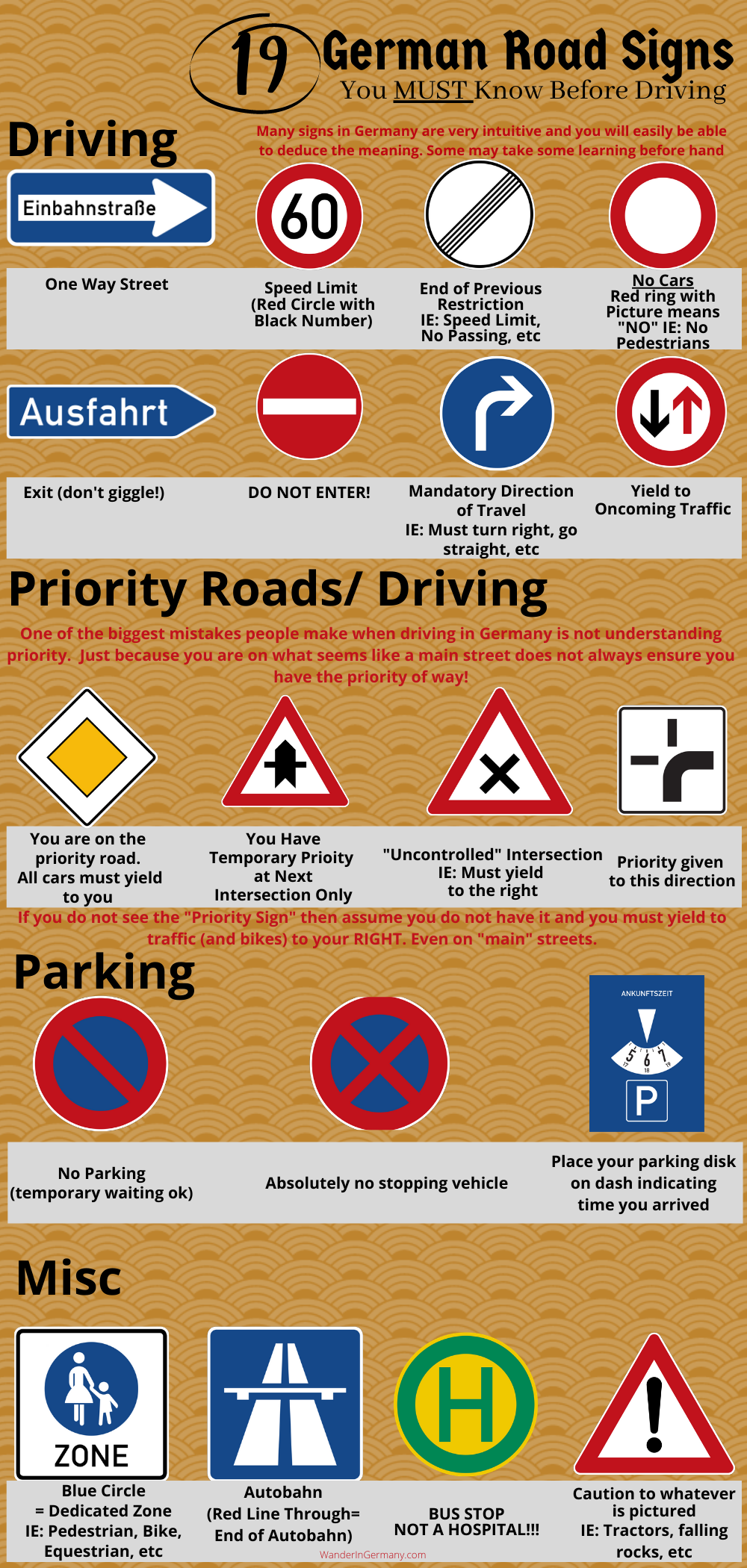
However, there are a few that almost always get tourists confused. Here are some of the most popular as well as potentially confusing road signs in Germany. This is obviously not an exhaustive list, so if you would like to see all the roadsigns in Germany (I highly recommend taking a look), here is a good source but here are just a few of the most common German signs and meanings.
^Pin It To Your “Germany Trip Planning” Board for Later^
Germany Driving Laws and Rules of the Road
At the end of the day, Germany traffic rules aren’t THAT much different than driving in other locations or countries, but there are a couple of differences that are HUGE deals that you do need to know before getting behind the wheel. Here are a few of the main differences and Germany driving rules that you’ll want to particularly be aware of when driving in Germany.
Drinking and Driving
The alcohol tolerance for driving is probably one of the most strict of the German driving laws (rightfully so). Germans take driving as a privilege, not as aright, and to drive after even having one beer, is jeopardizing your life and everyone else on the road with you.
Currently, the limit of alcohol is .5mg of alcohol per mm of blood. What does that translate to? For many people, that is actually just one normal German sized beer (the beer here is strong!)
Simply put, don’t be stupid. Don’t risk drinking and driving…..even a small amount!
Seatbelts and Car Seat Rules in Germany
Heading to Germany with Kids? Not surprisingly, seat belts is another one of the strict driving laws in Germany
- EVERYONE in the vehicle is required to wear a seatbelt. If a passenger is found without one, then the driver is held responsible with a high fine.
- Children 3 & Under must have a car seat.
- Children under twelve (and under 150cm) must have a booster or restraint system and be seated in the back
No Turn On Red Lights
In the US, this is so second hand nature, but it is one Germany road rules that will get you! Unless otherwise (rarely) noted, then you may NOT turn right on red lights.
Drive on the Right, Pass on the Left
I know I mentioned this previously in the Autobahn section but it is that important in Germany. Not only is it just rude etiquette and you’ll find yourself with an angry German flashing their lights at you, but it is also actually illegal on the Autobahn. Everywhere else it is just common courtesy.
Road Priorities
Right Has Priority

This is one of the “harder” rules for driving in Germany and takes some major awareness and getting used to. If you see a white diamond with a yellow diamond on the inside that means you are on a priority road and do not need to yield.

HOWEVER, in many places that FEEL like it should be a priority road, it just might not be. The German have a “Yield To the Right” rule in these situations (often on side or neighborhood roads, but even some within towns/ cities). So, without the priority sign, at an intersection, you must yield to the car on the right. This can be hard to remember and confusing at times, so always be on the lookout.
Round Abouts

There are plenty of roundabouts in Germany and I remember being equally terrified of these as I was of the Autobahn at first. When approaching the roundabout, you must yield to traffic already in the circle. When exiting the circle, use your blinker to indicate your exit.
Driving in Germany in Winter
I get asked all the time if it is hard driving in the winter in Germany or even dangerous. And while there are always exceptions to the rules, I’d say that generally speaking, no, it is not.
In most of Germany, you won’t see huge blizzards, even in the dead of the winter. That’s not to say that there aren’t times that we don’t get a good snowfall, but even then, unless you are at higher altitudes, it is often only a few inches at a time.
While side roads can get slick, the road services are in Germany are crazy fast and efficient. This is especially true for the Autobahn! The roads are often cleared very quickly and if it is an unusually big snowstorm, the Autobahn is typically the first to get attention.
Even if you plan on driving in the Alps in the winter (like to Neuschwanstein Castle), the roads are very well maintained, even in the winter.
Other Things To Know When Driving in Germany
Be Aware of Cyclists and Pedestrians
For many people coming from the US, we are taken back by the number of pedestrians and cyclists in German cities.
Germans are rule followers, so most likely, the pedestrians will wait patiently at the stoplights until they get the green walking man, but you still need to be very mindful when driving and always on the lookout for walkers.
Another thing to be particularly aware of is cyclists. In most big cities, there are designated bike paths along major streets. It often takes a moment of remembering to check for the bike lane before turning, for example, which many tourists aren’t familiar with doing. Alternatively, there are often places that you’ll be sharing the road with a cyclist, so just always be aware of your surroundings.
Traffic Cameras
Oh how I love German efficiency.
Instead of like in the US, where they plop a policeman and his vehicle in spots for hours with a speed trap, the Germans just put out cameras, where if you are speeding, you’ll get flashed.
Oh, no, not THAT kind of flashed!
No, you get a bright camera bulb flash right at your beautiful face and license plate number (so that they have clear evidence).
Getting “Blitzed” (again, no, not THAT kind of Blitzed) is often one of those “Oh Crap!” Moments where you then dread getting the fine in the mail a few weeks later. Don’t worry, if you get a ticket like this, your car rental agency will be happy to forward it along to you (along with a lovely processing fee, of course)
Environmental Zones
On your car, you will see a colored circle sticker in the corner with a number inside it. These are for the “Green Zones” which is an environmental protective measure, particularly in bigger cities that are trying to reduce pollution. Some bigger cities will have a Green Zone law, limiting vehicles to ones with the number 1. Most likely, your rental car will be the Green/ #1 sticker, just double check so that you avoid any issues, as you will get fined if you enter certain cities with higher numbered stickers.
Getting Gas in Germany
There’s no way to skirt around it. Getting gas in Europe is EXPENSIVE. I’m talking upwards of 2-3 times more expensive than what you might pay in the US, especially if your rental car in Germany is diesel (which is extremely common, but it also gives you better gas mileage on average).
Along the Autobahn, there are countless gas stations that you can stop at (many that are accompanied by some fantastic restaurants or even playgrounds for kids!) In the city, many gas stations are open from around 7am-8pm (give or take) so don’t just expect 24 hour service.
Another difference with gas stations in Germany is that you won’t find a “Pay at the Pump.” Therefore, when you pull up, select your gas type and fill up and then go inside. Tell the attendant what number pump you are at (don’t worry, most can speak English and if all else fails, just start pointing).
While credit cards aren’t as commonly used in Germany as in the US in places like restaurants, you should have no problem paying by card at a Germany gas station (assuming you have let your credit card know that you are traveling internationally)
Shop for the cheapest rental cars for Germany here:
Planning a Germany Road Trip
If you are looking for a great road trip to Germany, there are countless fantastic options! Here are just a few of my favorites:
- Romantic Road
- Wine Route (Weinstrasse)
- Fairytale Route (Märchenstraße)
- Allgäu Cheese Route

